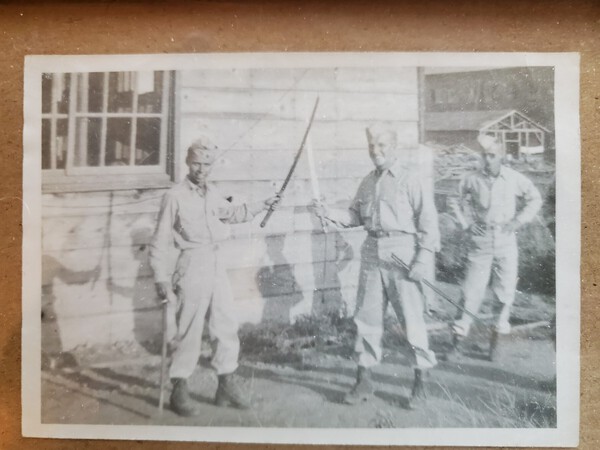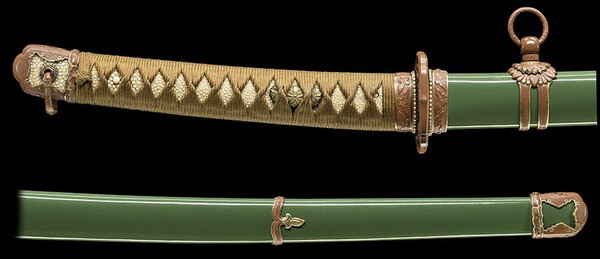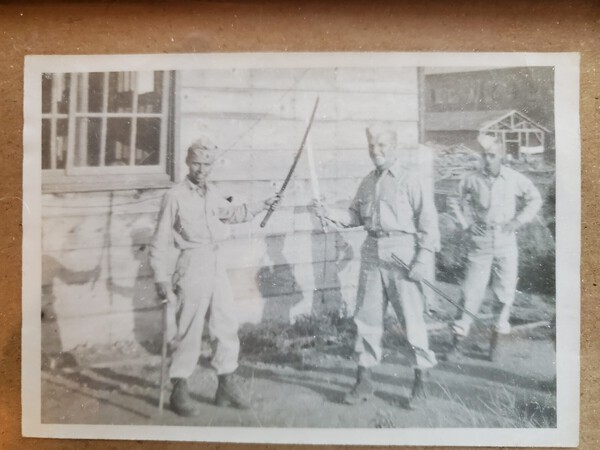
dwmc
Gold Tier-
Posts
602 -
Joined
-
Last visited
Content Type
Profiles
Forums
Events
Store
Downloads
Gallery
Everything posted by dwmc
-
In summary of posted Sword. 1. It's not a traditional Japanese made sword. 2. It's most likely a "Peta Katana" produced in Japanese occupied Indonesia during WWll. (Dave R.) 3. The term " Island Sword" is somewhat of a misnomer. Actual Japanese swords forged off main island are designated " Field or improvised." (As per Kiipu) 4. I incorrectly mentioned the sword was "field" made in Indonesia whereas it was probably produced by local sword smiths and is not a Japanese sword. (Yet a facsimile in many ways) After further research I noticed there's nothing new about these types of swords and has been discussed in the past (by myself also.) However, they do seem to show up on occasion and I guess could be legitimately considered part of WWll Pacific Theater history... Best regards, Dave M.
-
Got it, I think....Therefore, it should actually be called an "PETA katana" field made in Indonesia while under Japanese control. Thank you both, Dave M.
-
Thanks Thomas, Yes, definitely similarities between the two swords. I think between you, Hamfish, Dave, Bruce, Chris, the consensus is most certainly another one of the Island made type swords. I'll let the owner know the most likely area and type of sword as he currently has it incorrectly listed as "Old Japanese." Thank you all, Dave M.
-
Excellent Dave, I thought you would be the guy to sort this (somewhat) Japanese looking aberration out! Well done, Indonisian, makes perfect sense... Thanks again, Dave M.
-
Chris, These are a few additional pictures you mentioned. (I'm even further perplexed by the sword after looking at it again). I thought I could see a very tight Kanuka type hada, but not conclusively. The shinogi appears to be more near the center of the blade, and there is absolutely no movement in the habaki or tsuba, which seems strange, almost as if it is bound strongly together in some way. I tried to move the leather collar on the tsuka to see if there was a mekugi-ana beneath, the leather was extremely tight, and I didn't want to damage it further. All I can say is this is a very odd Japanese type sword which is beyond my ability understand. Possibly some sort of rebellion era sword, or possibly an old middle eastern attempt to imitate a Japanese sword. Lastly, maybe an Island sword as Bruce suspected..... Dave M.
-
Chris, I'll try and get better pictures of the blade, but as you know, even fairly good pictures of an out of polish blade don't turn out that well. However, at least we will see the overall blade shape (sugata). No, I wouldn't pay $695 for the sword, although, I might consider 3 or $400 just for the novelty of it in my collection. Dave R. Do you have any idea of what you think this sword may be?? Dave M.
-
Hi Chris, I also felt the Mokko shaped tsuba was a rather interesting for an island made sword, and yes, the leather and overall appearance seems to be at least eighty years old. The owner is asking $695. Dave M.
-
Thanks Bruce, I was kind of thinking that also.
-
I found this sword recently at an antique shop and took a few relatively poor photos, however, hopefully good enough to get a few opinions as to its origin. It appears to be a sword once covered in both saya and tsuka with leather, (tsuka leather removed.) There doesn't appear to be a mekugi- ana for tsuka removal. The habaki seems longer than normal. The Tsuba is rather plain with Mokko Gata shape. There are no seppa. The blade is severely out of polish with no visible hamon or hada and possibly a shobu zukuri sugata. The plate 66 (page 49) photo appears to be similar. (Fuller and Gregory 1868-1945) Is this a late war Japanese sword? An island made sword. Chinese fake??? Opinions much appreciated...Dave M.
-
WW2 Japanese sword (Fukumoto AMAHIDE)
dwmc replied to Swords's topic in General Nihonto Related Discussion
-
There's probably not another gunto with more miscellaneous names as the Type 3 shingunto. Four or five years ago, I believe it was Shamsy (Steve) suggested, based on the year 1940, it should actually be designated Type 0. Dave M.
-
Trystan's photo could very well be an example of a white saya. However, below is a photo of my father (on left) with one the swords he brought home. It shows, as Steve suggested, how deceptive the old black and white pictures can be, my father's sword was definitely not painted black, and his buddies not white. Dave M.
-
No problem Peter, all input appreciated, it's becoming apparent to me there are even a few slight variations in what could be considered traditional "Gunto green" as John and Gareth have shown. After looking closer at Victor's Mantetsu saya, which Bruce shared, it appears to be a greenish paint possibly applied post war. Again, all input is greatly appreciated, however, yours appears to be the closest to the "Bluish Green" saya color variation displayed in Ohmura's Gunto Site, however, I'm not sure we've quite got a match yet. I'm beginning to suspect that very specific Bluish Green saya color variation is extemely rare, if not produced in any number at all, an anomaly indeed. Perhaps one will eventually show up! Thank you all for the effort, Dave M.
-
Thanks Bruce, This is exactly the Saya color variation I was thinking of, perfect example ! The look of wwll era, age appropriate, excellent... You've established there are a least a few out there. Thanks again, Dave
-
-
Hopefully, someone will own and provide a photo of Type 98 with the green color variation saya, and additonal information as to it's construction material. Yes, have seen many Sharkskin saya's, but agree, green would be an odd color. Thanks again, Dave M.
-
On high resolution, I see what your saying, it does appear possibly a shark skin. Do you ever recall a Type 98 gunto showing up on the board with this variation of saya ? I think this may be a rare Saya indeed ! Dave
-
-
Ohmura's "Military Swords of Imperial Japan" has an example of a Bluish Green type 98 Gunto saya among several of the more common colors. My questions is, out of all the years I've followed the NMB, I can't recall seeing even one of the Green Saya's. Was this color saya more of an anomaly, or was it simply a color rarely chosen ??? Does anyone have one of these green colored saya's? I would think that if anyone had an example, it would be Neil (IJASWORDS) from Australia. Thanks in advance. Dave M.
-
Hi Ian, My father was there as a guard for General MacArthur during the surrender ceremony. I too have searched for years trying to locate footage of military activities during the surrender in the Yokohama area. I've found several short film clips on (Critical Past wwll archive ), yet don't recall seeing a sword surrender during that day of surrender ceremony. I have read however, that the Japanese officers during that time were still wearing their swords, and were promptly ordered to surrender them. Therefore, it's highly likely this is just how your sword was acquired. This is a photo of my father, (on left), with one of the swords he brought home. This wasn't a sword from the Yokohama surrender, but a sword from a weapons collection mission in northern Japan. Good luck with your research, Dave M.
-
Thanks Brandon, I had also considered a Rai smith, but was thinking Masa or Sada, however, I believe your Kuni character is more likely correct! Thanks again, Dave
-
I think I'm possibly seeing a Mune and a Mitsu kanji, however, there seems to be horizontal strokes in between???Dave M.
-
Another help with first Japanese sword
dwmc replied to Levallois's topic in Military Swords of Japan
There are a couple of ishizuki available on the ebay site ( 4520genkidayo ) at the present time. However, as PNSSHOGUN (John) mentioned, Shin Gunto fittings are difficult to match in exact size as they are made for each individual saya. Best bet is to attend one of Japanese sword shows in the the US and fit ishizuki in hand for as close as possible fitting... Dave -
Is it possible some of these nakago symbol's and fitting numbers are more ritual/spiritual than manufacturing codes. The number 6 is not considered a lucky number in Japan, however, 3x5=15 or 3+6+6=15 which results in 5 number 3's which are considered lucky? Are the three dots on the nakago possibly an aposiopesis, suggesting trailing off in to silence, or something that continues spiritually unspoken? The square another spiritual/ritual symbol, for instance the significance of pouring sake into a glass inside a masu, or one of many possibilities of a face/figure inside a square? Just a thought, Dave M.
-
Excellent Sword Gareth! Beyond a bit of age discoloration on the fittings, the sword looks as though it could have been made a month ago. Hopefully, Bruce Pennington or one of the other members can help identify the nakago stamp and habaki kanji... Very nice indeed, Dave M.


.thumb.jpg.324dc3c141441e81f41a5194f5f16ae0.jpg)
.thumb.jpg.7d9ba1450be51212207b708703e741d1.jpg)
.thumb.jpg.81d4ea1c72ff129b1dc3ae22f3beab98.jpg)
.thumb.jpg.8d9a17b2968ffb3de1ce12f5c2734fc2.jpg)
.thumb.jpg.e6754418c86999c29b64780d920b11fc.jpg)
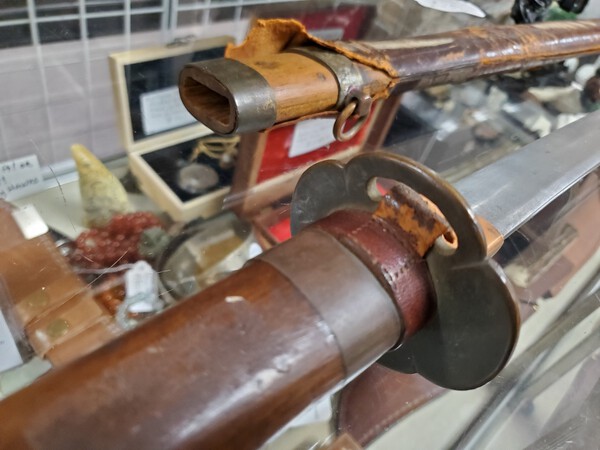
.thumb.jpg.858d4cbf27755b663d4e9b14ad9a1574.jpg)
.thumb.jpg.6859c6b71ece1c1dde131800e51c40c7.jpg)
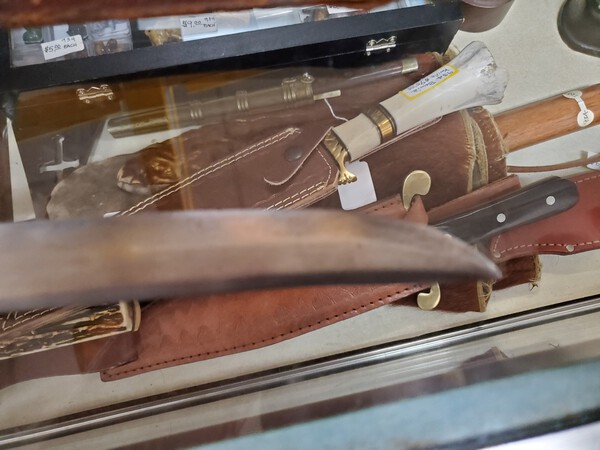
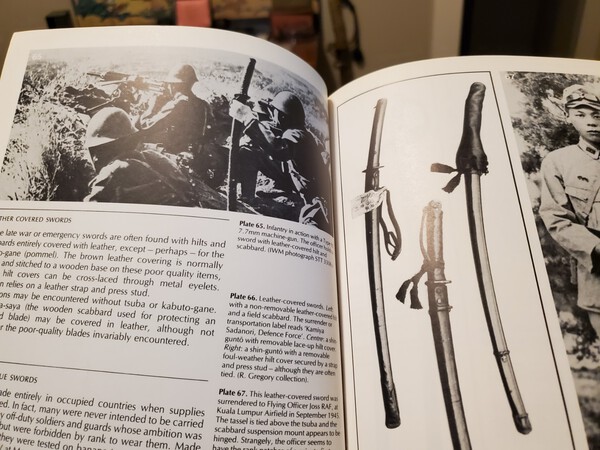
.thumb.jpg.d03a2667fce321c7a2391aa85cd88f92.jpg)
